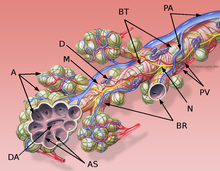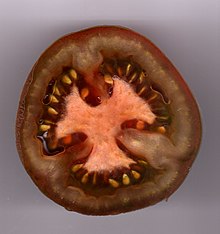Septum
In biology, a septum (Latin for something that encloses; pl.: septa) is a wall, dividing a cavity or structure into smaller ones. A cavity or structure divided in this way may be referred to as septate.
Examples
[edit]Human anatomy
[edit]- Interatrial septum, the wall of tissue that is a sectional part of the left and right atria of the heart[1]

- Interventricular septum, the wall separating the left and right ventricles of the heart[2]
- Lingual septum, a vertical layer of fibrous tissue that separates the halves of the tongue[3]

- Nasal septum: the cartilage wall separating the nostrils of the nose[4]

- Alveolar septum: the thin wall which separates the alveoli from each other in the lungs[5]
- Orbital septum, a palpebral ligament in the upper and lower eyelids[6]
- Septum pellucidum or septum lucidum, a thin structure separating two fluid pockets in the brain[7]
- Uterine septum, a malformation of the uterus[8]
- Penile septum, a fibrous wall between the two corpora cavernosa penis[9]
- Septum glandis, partition of the ventral aspect of the glans penis[10]
- Scrotal septum, layer of tissue dividing the scrotum[11]
- Vaginal septum, a lateral or transverse partition inside the vagina[12]
- Intermuscular septa separating the muscles of the arms and legs
Histological septa are seen throughout most tissues of the body, particularly where they are needed to stiffen soft cellular tissue, and they also provide planes of ingress for small blood vessels.[citation needed] Because the dense collagen fibres of a septum usually extend out into the softer adjacent tissues, microscopic fibrous septa are less clearly defined than the macroscopic types of septa listed above.[13] In rare instances, a septum is a cross-wall. Thus it divides a structure into smaller parts.[14]
Cell biology
[edit]The septum (cell biology) is the boundary formed between dividing cells in the course of cell division.[15]

Fungus
[edit]
Botany
[edit]
- A partition that separates the locules of a fruit, anther, or sporangium.[17]
Zoology
[edit]A coral septum is one of the radial calcareous plates in the corallites of a coral.[18]
Annelids have septa that divide their coelom into segmented chambers.[19]
Many shelled organisms have septa subdividing their shell chamber, including rhizopods, cephalopods and gastropods, the latter seemingly serving as a defence against shell-boring predators.[20][21]
Laboratory technology
[edit]- A rubber septum is an engineered membrane that permits transfer of a substance (usually liquid or gas) without contact with air, usually using a syringe with needle.[citation needed]
References
[edit]- ^ Naqvi, Nitha; McCarthy, Karen P.; Ho, Siew Yen (2018). "Anatomy of the atrial septum and interatrial communications". Journal of Thoracic Disease. 10 (S24): S2837–S2847. doi:10.21037/jtd.2018.02.18. PMC 6174145. PMID 30305943.
- ^ Carlson, Bruce M. (2014-11-28). "Development of the Heart". Reference Module in Biomedical Sciences. University of Michigan, Ann Arbor, Michigan. doi:10.1016/B978-0-12-801238-3.05460-X. ISBN 9780128012383.
{{cite book}}: CS1 maint: date and year (link) CS1 maint: location missing publisher (link) - ^ Gleichmann, Natasha; Creighton, Elizabeth; Zhu, Austin; Willard, Nicholas; Yang, Jeremy; Herrmann, Brian W (2023-07-25). "Concurrent Pediatric Lingual and Submental Dermoid Cysts: Case Report and Literature Review". Cureus. 15 (7): e42429. doi:10.7759/cureus.42429. ISSN 2168-8184. PMC 10448783. PMID 37637563.
- ^ Vaid, Sanjay; Vaid, Neelam (2022-11-01). "Sinonasal Anatomy". Neuroimaging Clinics of North America. Neuroimaging Anatomy, Part 2: Head, Neck, and Spine. 32 (4): 713–734. doi:10.1016/j.nic.2022.07.007. ISSN 1052-5149. PMID 36244719.
- ^ Kesharwani, Prashant (2019). "Chapter 1 - An Overview of the Anatomy and Physiology of the Lung". Nanotechnology-Based Targeted Drug Delivery Systems for Lung Cancer (1st ed.). New Delhi, India: Academic Press. pp. 1–20. doi:10.1016/C2017-0-03894-6. ISBN 978-0-12-815720-6. Retrieved 2024-08-27.
- ^ Davies, Hannah J; Webster, Andora Melany; McCance, Eleanor; Watts, Patrick; Evans, Jordan (2023-12-01). "Seeing beyond the swelling: orbital and preseptal cellulitis in children". Paediatrics and Child Health. 33 (12): 369–375. doi:10.1016/j.paed.2023.09.002. ISSN 1751-7222.
- ^ Fantasia, Ilaria; Ciardo, Claudia; Bracalente, Gabriella; Filippi, Elisa; Murru, Flora Maria; Spezzacatene, Anita; Bin, Maura; Mendez Quintero, Olivia; Montaguti, Elisa; Lees, Christoph; Papanikolaou, Katherine; Pilu, Gianluigi; Prefumo, Federico; Thilaganathan, Baskaran; Stampalija, Tamara (2023-04-14). "Obliterated cavum septi pellucidi: Clinical significance and role of fetal magnetic resonance". Acta Obstetricia et Gynecologica Scandinavica. 102 (6): 744–750. doi:10.1111/aogs.14575. ISSN 0001-6349. PMC 10201966. PMID 37059118.
- ^ Homer, Hayden A; Li, Tin-Chiu; Cooke, Ian D (2000-01-01). "The septate uterus: a review of management and reproductive outcome". Fertility and Sterility. 73 (1): 1–14. doi:10.1016/S0015-0282(99)00480-X. ISSN 0015-0282. PMID 10632403.
- ^ Kirkham, A (2012-11-01). "MRI of the penis". The British Journal of Radiology. 85 (special_issue_1): S86–S93. doi:10.1259/bjr/63301362. ISSN 0007-1285. PMC 3746407. PMID 23118102.
- ^ Ozbey, Huseyin; Kumbasar, Ali (2017-11-10). "Glans wings are separated ventrally by the septum glandis and frenulum penis: MRI documentation and surgical implications". Türk Üroloji Dergisi/Turkish Journal of Urology. 43 (4): 525–529. doi:10.5152/tud.2017.00334. PMC 5687219. PMID 29201519.
- ^ Patel, Abhishek P. (2017-05-20). "Anatomy and physiology of chronic scrotal pain". Translational Andrology and Urology. 6 (S1): S51–S56. doi:10.21037/tau.2017.05.32. PMC 5503924. PMID 28725619.
- ^ Heinonen, P.K. (1982). "Longitudinal vaginal septum". European Journal of Obstetrics & Gynecology and Reproductive Biology. 13 (4): 253–258. doi:10.1016/0028-2243(82)90106-X. PMID 7117657.
- ^ Burt, Alastair D.; Ferrell, Linda D.; Portmann, Bernard C. (2011). "1 - Anatomy, pathophysiology and basic mechanisms of disease". MacSween's Pathology of the Liver (6th ed.). Churchill Livingstone. pp. 1–77. doi:10.1016/C2009-0-47964-9. ISBN 978-0-7020-3398-8.
- ^ Yu, Mengyao; Harper, Andrew R.; Aguirre, Matthew; Pittman, Maureen; Tcheandjieu, Catherine; Amgalan, Dulguun; Grace, Christopher; Goel, Anuj; Farrall, Martin; Xiao, Ke; Engreitz, Jesse; Pollard, Katherine S.; Watkins, Hugh; Priest, James R. (2023). "Genetic Determinants of the Interventricular Septum Are Linked to Ventricular Septal Defects and Hypertrophic Cardiomyopathy". Circulation: Genomic and Precision Medicine. 16 (3): 207–215. doi:10.1161/CIRCGEN.122.003708. ISSN 2574-8300. PMC 10293084. PMID 37017090.
- ^ Khanna, Kanika; Lopez-Garrido, Javier; Sugie, Joseph; Pogliano, Kit; Villa, Elizabeth (2021-05-21). "Asymmetric localization of the cell division machinery during Bacillus subtilis sporulation". eLife. 10. doi:10.7554/eLife.62204. ISSN 2050-084X. PMC 8192124. PMID 34018921.
- ^ Rittenour, William R.; Si, Haoyu; Harris, Steven D. (2009-02-01). "Hyphal morphogenesis in Aspergillus nidulans". Fungal Biology Reviews. 23 (1): 20–29. Bibcode:2009FunBR..23...20R. doi:10.1016/j.fbr.2009.08.001. ISSN 1749-4613.
- ^ Hong, De-Yuan (2015). "Chapter 2 - Biology". A Monograph of Codonopsis and Allied Genera (Campanulaceae) (1st ed.). Academic Press. pp. 9–41. doi:10.1016/C2013-0-23184-6. ISBN 978-0-12-801933-7. Retrieved 2024-08-27.
- ^ Scrutton, Colin (12 May 1998). "The Palaeozoic corals, II: Structure, variation and palaeoecology". Research Gate.
- ^ Squire, Larry R. (2009). "Biomechanics: Hydroskeletal". Encyclopedia of Neuroscience. Academic Press. pp. 189–200. doi:10.1016/B978-008045046-9.01948-3. ISBN 978-0-08-045046-9. Retrieved 2024-08-27.
- ^ Ishikawa, Makiko; Kase, Tomoki; Tsutsui, Hidekazu (2018). "Deciphering deterministic factors of predation pressures in deep time". Scientific Reports. 8 (1): 17532. Bibcode:2018NatSR...817532I. doi:10.1038/s41598-018-35505-1. PMC 6277388. PMID 30510248.
- ^ Vermeij, Geerat J. (1982). "Unsuccessful Predation and Evolution". The American Naturalist. 120 (6): 701–720. doi:10.1086/284025. S2CID 84610680.
